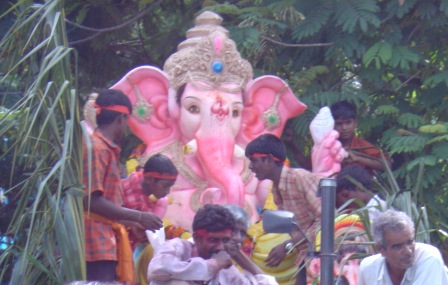Now that we're living in India, we're
getting used to a new set of holidays. This is the beginning
of the holiday season, which runs this year from September
7 until November 1. Last Wednesday
was the seventh, and the holiday was Ganesh Charturthi,
which starts on the fourth day after the new moon and runs
for eleven nights. Charturthi
means fourth in Sanskrit, and Ganesh is the god who is
being honored. He's the god with the elephant head – the smart
son of Shiva and Parvati.
Here's what happens during this holiday: First, every family
and every neighborhood and every village makes a new
plaster or clay Ganesh statue. In the house, these statues
are twelve inches tall and
sit in the prayer (puja) room. In the neighborhoods and
villages, these statues range from three to thirty feet
tall, and special outdoor plywood
puja rooms are constructed for them.
The Ganesh statues then get painted and decorated. Every morning and
evening, people put food around the statue – Ganesh’s favorite
food is laddu, a sweet made out of chick pea flour (more on that later).
Bunches of coconuts, broken open by different people each morning, lie
at his feet.
Hyderabad takes Ganesh Charturthi seriously. There are fifteen thousand
neighborhood Ganesh statues spread around the city, living in their
temporary three-sided rooms. If you drive around town in the evening,
you pass by hundreds of them. The puja rooms are lit up with blinking
strings of lights, and spotlights shine on the statues.
In the evenings, people come and sit in front of the puja room, admiring
the statue, saying their prayers, and mingling together. Then later
on at night, the men and boys have a big party, and stay up late singing
songs and dancing in front of Ganesh. This gets pretty loud for those
of us trying to sleep. At midnight a curtain is drawn over open side
of the puja room, and Ganesh rests until morning.
The full moon comes on the eleventh night, and the holiday is over.
Now here’s the problem: what to do with fifteen thousand large
plaster and clay statues? You can’t just break them up; that would
be dishonorable to Ganesh. Fortunately, there’s a very colorful
solution to this problem: return Ganesh to the water.
 For whatever reason, even numbered days are not good days for a drowning,
and odd numbered days are great. Starting on the fifth day (the eleventh
is best, but I think it also depends on how crowded the lake- or river-side
gets), the men find a big open-bed trunk, load Ganesh onto it, tie on
orange headbands, and cover their heads and bodies and clothes with
fluorescent purple paint. They clamber aboard the truck, crank up the
music, sing at the top of their lungs, and slowly drive to the closest
river or lake. Along the way, they spray purple paint on the people,
dogs, and cars they pass. Then they lift the statue out of truck, and
four of the men carry Ganesh into the water, where he sinks to the bottom.
The men standing on the shore help the guys out of the water, and they
spend the rest of the night partying. A cool holiday, especially for
the guys. For whatever reason, even numbered days are not good days for a drowning,
and odd numbered days are great. Starting on the fifth day (the eleventh
is best, but I think it also depends on how crowded the lake- or river-side
gets), the men find a big open-bed trunk, load Ganesh onto it, tie on
orange headbands, and cover their heads and bodies and clothes with
fluorescent purple paint. They clamber aboard the truck, crank up the
music, sing at the top of their lungs, and slowly drive to the closest
river or lake. Along the way, they spray purple paint on the people,
dogs, and cars they pass. Then they lift the statue out of truck, and
four of the men carry Ganesh into the water, where he sinks to the bottom.
The men standing on the shore help the guys out of the water, and they
spend the rest of the night partying. A cool holiday, especially for
the guys.
While we were driving to Nagarjuna Saga Dam last Sunday,
Sreelekha told us the story of how Ganesh got his elephant
head. I wrote it down
so we could all enjoy it. Then I asked Shreelekha's mom
to verify the accuracy, and Sreelekha got into trouble
for not getting the details
right. Chaitanya came to the rescue and corrected it,
so I think it’s
close
...
Why Ganesh has an Elephant Head
as told to me by Sreelekha
and corrected for her by Chaitanya
The story starts with Gajasura, a vicious elephant demon. Gajasura
was on the rampage, killing lots of innocent people,
making a real nuisance in the local village. Shiva was pretty happy
with this - he's
one of the three main gods in Hinduism. His job each time he comes back
is to destroy the world. Although he loves destruction, he acts a little
naïve, and he ends up trusting people when he should be avoiding
them.
Case in point: Gajasura. Shiva was so happy with the elephant
demon that he promised him that he would grant whatever Gajasura
wished for.
So Gajasura wished that he would live forever with
Shiva living inside of his stomach. Nice for Gajasura, but not so
nice for Shiva. See what
I mean about naïve?
Now it seems that Indian gods need to keep their promises. That’s
good for us, otherwise the story would be over, and we still wouldn’t
know about Ganesh’s elephant head. So let’s continue: Shiva
is inside of Gajasura, and Parvati, Shiva’s wife, is unable
to find him.
Parvati asked Vishnu to help find Shiva. Vishnu found out what
happened, and used his own trickery on Gajasura: he disguised himself
as a bear,
and started dancing some really cool steps. Gajasura
saw the dance, and was totally delighted by the moves, and told
the bear that he’d
grant him a wish.
Elephant demons are as naïve as the gods, I guess. Vishnu said “I
want by buddy Shiva back,” and Shiva burst out, ripping open Gajasura’s
belly. Shiva was so mad that he grabbed his trident and chopped off
Gajasura’s head.
As his head went rolling by Shiva, Gajasura told Shiva that he
was sorry, and that he wished he was still alive, so he could do
more things
for him. Shiva started feeling really bad about this,
and he told Gajasura that he’d figure something out. Then
Shiva headed back home to Parvati.
While Vishnu was out retrieving Shiva from Gajasura’s stomach,
Parvati wanted to take a bath. In the times of this story, people used
chick pea flour as a soap to scrub off the dirt. Parvati molded a little
boy out of the chick pea flour. She then brought the boy to life, and
named him Ganesh – her and Shiva’s new son.
Usually when Parvati bathed, she had somebody watch the house and the
door. Since Shiva was still missing, she asked Ganesh to keep everybody
out. Ganesh, eager to please his mom, stood outside the door.
But as you probably already guessed, Shiva chose that moment to
come home. Dad and son hadn’t met yet, and each time Shiva tried to
pass, Ganesh stopped him. Pretty soon Shiva was rip-roaring mad, and
he whipped out his trident, lopped off Ganesh’s head, and charged
into Parvati’s bathing room.
Not a pretty scene: Shiva, grasping his dripping trident in one
hand, holding up Ganesh’s head in the other. Parvati, startled
at his entry, wailing over the loss of their brand new son, and
screaming at
Shiva to find a way to bring him back to life.
Shiva’s specialty was in taking lives, not restoring them. He
found Vishnu and asked him to bring his new son back to life. Vishnu
looked at Ganesh’s body and said that the only way to bring
back the boy would be to find another head, facing south, and to
attach it
to the body.
Now that was something that Shiva could help with. As luck would
have it, he just happened to have left Gajasua’s head facing south.
He retrieved Gajusura’s head, Vishnu attached it to the chick
pea flour body, and Ganesh sprang to life. And that
is why Ganesh has an elephant head.
I asked Sreelekha if the story had any lessons for us to learn. She
looked at me, and said sternly, “These are not fables, Dennis.
They don’t need morals.” Oops. So I decided to come up with
my own lessons for the main characters:
For Shiva and Gajasura: add some caveats to your wish granting promises.
For Parvati: use something stronger than chick pea flour when you make
your babies.
For Ganesh: Unless you want big ears and a long nose, stay out of the
way of guys with tridents.
For Sreelekha and Chaitanya: Careful to whom you tell your stories,
as they may end up online.
|

 For whatever reason, even numbered days are not good days for a drowning,
and odd numbered days are great. Starting on the fifth day (the eleventh
is best, but I think it also depends on how crowded the lake- or river-side
gets), the men find a big open-bed trunk, load Ganesh onto it, tie on
orange headbands, and cover their heads and bodies and clothes with
fluorescent purple paint. They clamber aboard the truck, crank up the
music, sing at the top of their lungs, and slowly drive to the closest
river or lake. Along the way, they spray purple paint on the people,
dogs, and cars they pass. Then they lift the statue out of truck, and
four of the men carry Ganesh into the water, where he sinks to the bottom.
The men standing on the shore help the guys out of the water, and they
spend the rest of the night partying. A cool holiday, especially for
the guys.
For whatever reason, even numbered days are not good days for a drowning,
and odd numbered days are great. Starting on the fifth day (the eleventh
is best, but I think it also depends on how crowded the lake- or river-side
gets), the men find a big open-bed trunk, load Ganesh onto it, tie on
orange headbands, and cover their heads and bodies and clothes with
fluorescent purple paint. They clamber aboard the truck, crank up the
music, sing at the top of their lungs, and slowly drive to the closest
river or lake. Along the way, they spray purple paint on the people,
dogs, and cars they pass. Then they lift the statue out of truck, and
four of the men carry Ganesh into the water, where he sinks to the bottom.
The men standing on the shore help the guys out of the water, and they
spend the rest of the night partying. A cool holiday, especially for
the guys.